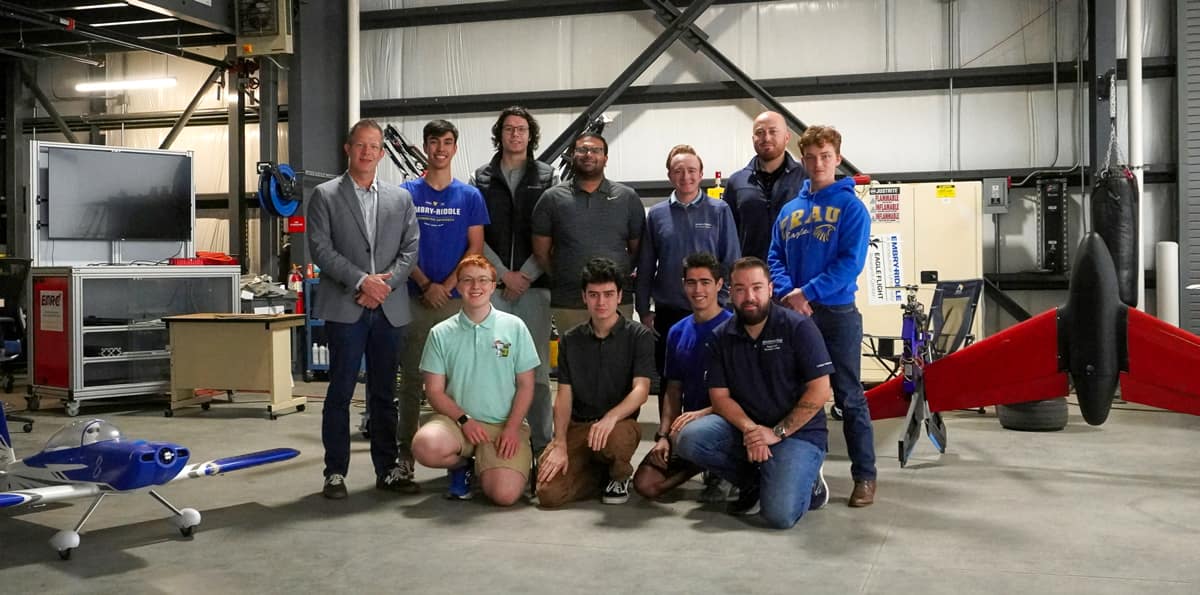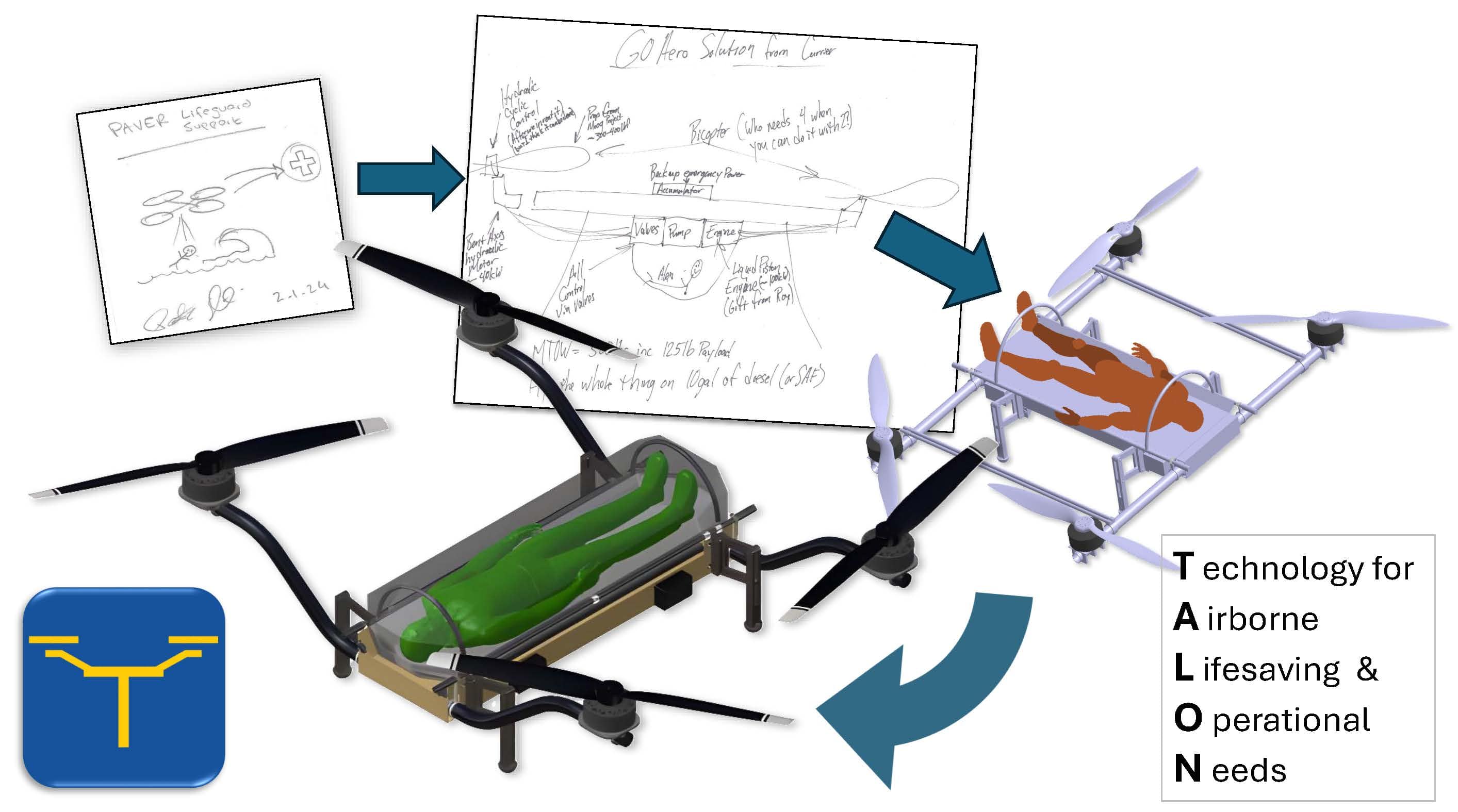Embry-Riddle Student Team Creates a Life-Saving Aircraft for Emergency Response

When Giol Vinyals i Roca was a child growing up in Catalonia, his parents gave him a remote-controlled toy helicopter with a red cross on it. The challenge of figuring out how it worked and fixing it when it crashed was exciting to him, and he and his brothers used Lego figures to simulate rescue missions.
Now a freshman in Aerospace Engineering at Embry-Riddle Aeronautical University, Vinyals i Roca has the opportunity to work with and learn from mentors and fellow students working on a flying vehicle project aimed at saving lives while keeping rescuers safe. He, project manager Patric Hruswicki, project lead Victor Cova and seven other team members were recently selected by the international GoAERO Prize competition, with support from NASA, to receive funding to build a compact emergency response aircraft.
“When I heard about GoAERO, I immediately knew that I wanted to be part of this amazing challenge, and when I found out there was an ERAU team, I was very excited to be able to work alongside such great engineers,” said Vinyals i Roca, who is the team’s avionics lead and propulsion system engineer.
The Embry-Riddle team’s aircraft prototype is called TALON, which stands for Technology for Airborne Lifesaving and Operational Needs. The vehicle takes off and lands vertically, like a helicopter, and is an uncrewed aerial vehicle, meaning it is controlled remotely or operates autonomously. Development of the aircraft has so far been funded by the Eagle Flight Research Center at the Daytona Beach Campus.
One innovation the team is working on for TALON is robotic, independently self-adjusting landing gear. Another potential innovation is an ability for the aircraft to fly and maneuver even if one of its four rotors is knocked offline, said Cova, a junior in Aerospace Engineering and the project’s design lead.

A diagram showing some of the steps in the evolution of the TALON uncrewed aerial vehicle, an aircraft designed for emergency rescue. (Illustration: Patric Hruswicki/Embry-Riddle)
Cova, who is from Madrid and was also intrigued by aviation at an early age, said that he got involved with the TALON project because he was interested in hands-on research and that the Eagle Flight Research Center “had the facilities, faculty and knowledge.” Cova said the project has provided him with invaluable experience, overseeing its design and the CAD (computer-assisted design), as well as delegating jobs and training students new to the project.
“Working on this project has been immensely valuable to me because I have had the chance to work very closely with faculty who have years of experience,” he said. “This has improved my soft skills like teamwork, engineering approach to a problem, analysis and communication, as well as hard skills like soldering, electrical circuit analysis and engineering design.”
Vinyals i Roca, who is a mountain trekker and skier, said that in high-altitude emergencies, helicopters are often the only rescue option, and the cost and complexity of such rescues means they are often reserved for life-or-death situations. Also, even in life-or-death situations, violent weather can ground helicopters, making rescue impossible.
The alternative proposed by the Embry-Riddle team is a cost-effective vehicle that could rescue people in such high-altitude emergencies and in a wide range of other emergency situations. This includes retrieving flood victims, withdrawing firefighters on a burning hillside or quickly transporting a first responder in a dense, traffic-clogged urban environment, among other possibilities.
Its passenger compartment holds a standard stretcher. It can deliver a first responder to someone needing to be rescued, and the first responder can then attend to the person and load them into the aircraft for transport. If the person needing to be rescued is not injured, the vehicle could be sent empty to pick the person up and deliver him or her to safety.
“The big value I see about this competition is applying the latest tech to a practical application,” said Hruswicki, a graduate student in Uncrewed and Autonomous Systems who is TALON Lift team lead and lead project manager at the Eagle Flight Research Center. “Lots of inventions fizzle because they were created without a direct need for them. Here, our guidelines are clear, so it'll be easier to stay focused and motivated with the goal in sight.”
Among 14 finalists in the GoAERO competition, Embry-Riddle’s TALON Lift team will continue refining their concept. A number of participating teams will advance to a flyoff scheduled to take place in 2027.
Dr. Kyle Collins, research assistant professor in the Department of Aerospace Engineering and director of the Eagle Flight Research Center, explained how the team’s TALON project grew out of long-term research.
“The (EFRC) has been performing research on rotorcraft testbeds for a number of years. Recently, we have developed and built large quad-heli airframes and developed unique fault-tolerant controls laws to fly them,” Collins said, crediting Cova with “a lot of the lifting” on the project. “This GoAERO competition is giving the EFRC a chance to put this experience to the test, and we think that we have the knowledge and build-space required to not only be competitive, but to win.”
NASA’s University Innovation Project and GoAERO are providing a total of more than $2 million to the winning teams. The funding can be used to purchase materials to build their aircraft. GoAERO also provides teams with mentorship, educational opportunities and access to specialized software. Three Embry-Riddle alumni –— Darshan Divakaran, Bill Lewis and Darin Underwood — are serving as GoAERO mentors.

 Michaela Jarvis
Michaela Jarvis